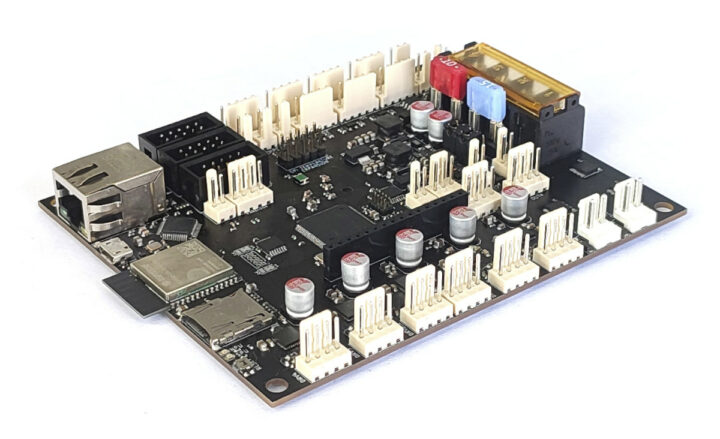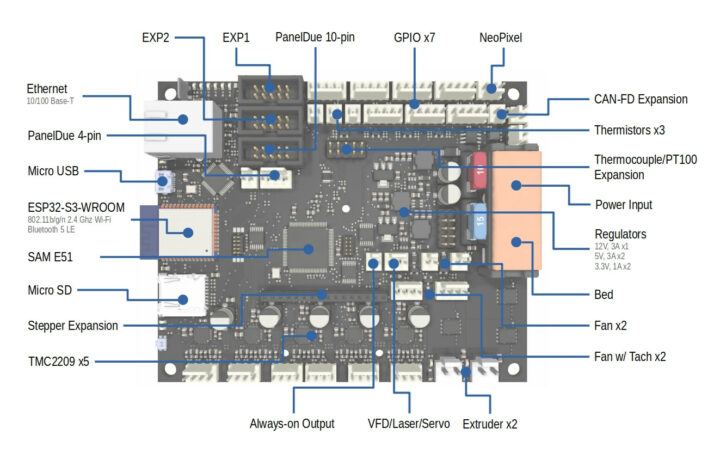Here’s another ESP32 3D printer controller board with the Phi MainBoard 5LC powered by both an ESP32-S3-WROOM module and a Microchip SAME51 Cortex-M4F microcontroller, and providing Ethernet and WiFi connectivity.
Designed by Likha Labs from the Philippines, Phi MainBoard 5LC is pre-loaded with RepRapFirmware firmware running the Duet Web Control interface that allows users to upload G-code files, configure settings, start jobs, control the device, and monitor prints. Besides 3D printers, the developers explain the board can also be used to drive other digital-fabrication equipment, such as CNC machines.
 Phi MainBoard 5LC 3D printer controller specifications:
Phi MainBoard 5LC 3D printer controller specifications:
- MCU
- Espressif Systems ESP32-S3 dual-core Xtensa LX7 WiFi and Bluetooth microcontroller @ 240 MHz with 512 KB SRAM, 8 MB SPI flash via ESP32-S3-WROOM-1-N8 module
- Microchip ATSAME51N19A Cortex-M4F microcontroller @ 120 MHz with 512 KB flash, 192KB SRAM
- Storage – MicroSD card socket
- Connectivity
- 10/100M Ethernet
- 802.11b/g/n 2.4 GHz Wi-Fi 4
- Bluetooth 5.0 LE
- USB – 1x Micro USB 2.0 port up to 12 Mbps
- Machine features
- 5x TMC2209 stepper drivers with up to 256x micro stepping
- 2x extruder heaters, each up to 5A
- 1x bed heater up to 15A
- 3x thermistors or PT1000s
- 4x PWM fans, 1x always-on
- 1x VFD/Laser/Servo (5V output)
- 7x GPIO ports with 30 V tolerant inputs, 3.3 V outputs for end stops, filament monitors, Z-probes, SSRs, etc…
- Specialty ports
- Power Supply
- Input voltage – 11V – 25V DC
- Input connector rated up to 25A
- On-board regulators – 1x 12V, 3A, 2x 5V, 3A, 2x 3.3V, 1A
- Dimensions – 123 x 100 mm, M4 mounting holes (4-layer PCB)
 The ESP32-S3-WROOM module handles networking, USB communication SD card storage, and displays, while the Microchip SAM E51 microcontroller takes care of real-time tasks like kinematics, stepping, digital and analog I/Os. A Github repository has been readied for the project, but it’s currently empty. Likha Labs say they’ll eventually upload hardware design files and publish documentation there. While they do not highlight that ESP32-S3 comes with AI instructions, I wonder if they could eventually be put to good use to detect issues or defects during printing and alert the user.
The ESP32-S3-WROOM module handles networking, USB communication SD card storage, and displays, while the Microchip SAM E51 microcontroller takes care of real-time tasks like kinematics, stepping, digital and analog I/Os. A Github repository has been readied for the project, but it’s currently empty. Likha Labs say they’ll eventually upload hardware design files and publish documentation there. While they do not highlight that ESP32-S3 comes with AI instructions, I wonder if they could eventually be put to good use to detect issues or defects during printing and alert the user.
Phi MainBoard 5LC has just launched on Crowd Supply with a funding $55,000 target. There’s a single reward at $149 for the controller board pre-flashed with the firmware, a MicroSD card with the content to get started, and a bag of crimps, terminals, and housings for Molex KK 254, JST VH, and screw connectors. Shipping is free to the US and $14 to the rest of the world, and backers should expect the controller to ship in July 2022 if everything goes according to plans.

Jean-Luc started CNX Software in 2010 as a part-time endeavor, before quitting his job as a software engineering manager, and starting to write daily news, and reviews full time later in 2011.
Support CNX Software! Donate via cryptocurrencies, become a Patron on Patreon, or purchase goods on Amazon or Aliexpress




